
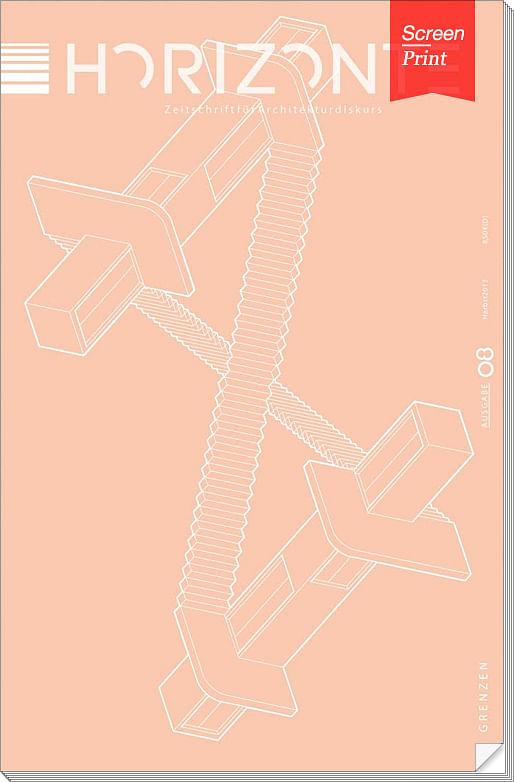
Screen/Print is an experiment in translation across media, featuring a close-up digital look at printed architectural writing. Divorcing content from the physical page, the series lends a new perspective to nuanced architectural thought.
For this issue, we’re featuring Horizonte's Ausgabe 08.
Do you run an architectural publication? If you’d like to submit a piece of writing to Screen/Print, please send us a message.
Grafted from the eponymous student-run lecture series at Bauhaus-University Weimar, HORIZONTE - Journal for Architectural Discourse is a collection of thought-pieces, interviews, photography and projects. Published twice a year, the publication allows for ideas brought up during the lectures to bloom a bit further, and commit them to a more memorable format. While its subtitle labels it as place for Architectural Discourse, the content is a rich collaborative effort from students in the schools of Architecture, Design and Media Studies.
Among the articles present in Ausgabe 08, we’ll be featuring Tyler Survant’s “Biological Borderlands: Ant Farm’s Zoopolitics”. Ant Farm was an avant-garde artist collective, based out of San Francisco during the 1960s and 70s, focusing on work that engaged the built environment in both architectural and ecological senses. Survant takes a close look at their “Dolphin Embassy” project, a co-habitation space for the species' mutual education.
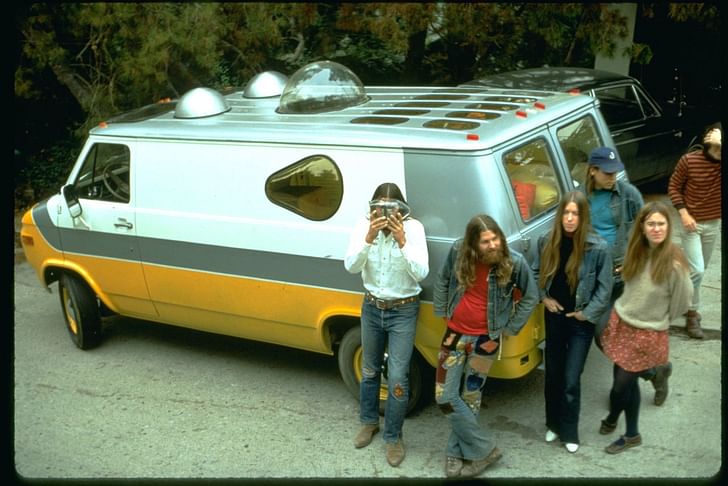
From Horizonte's Ausgabe 08:

Biological Borderlands: Ant Farm’s Zoopolitics
Humans are animals of relocation, changers of milieu, translators.
They are, ontologically speaking, amphibians.
- Peter Sloterdijk, Neither Sun nor Death
The pneumatic sail deflates over the starboard hull and the vessel lowers on its hydrofoils, gliding to rest. Seawater flows through its corridors and electricity through its shipboard equipment. Shaped like a ‘Bobby Brown’ (the triangular doughnut), it appears bright canary yellow in the sun. Bubble windows puncture its bulging hulls, and in them gather expectant figures, some wearing wet suits, others lab coats, who look not toward the horizon but the sea below. Perhaps it is the Coral Sea, or maybe the Gulf of Carpentaria; the ocean is calm and beneath its surface swims a pod of dolphins. One by one, they dart into the craft through a hollow hydrofoil. In the Dolphin-Human Lounge Grotto, an atrium and artificial woodland, researchers wade in to greet the new inhabitants. In this vessel, the Dolphin Embassy, the two species will share a new world, a half-wet, half-dry network of labs and living rooms for interspecies cohabitation.
Ant Farm, the American radical art and architecture collective of the Sixties, is often discussed in the context of media and mobility. TVs and automobiles abound in the Ants’ work. But what about their recurrent zoological motifs? A colony of insects, several species of reptiles, and a couple mammals—most notably a marine mammal—inhabit Ant Farm projects. A zoological thread begins with the collective’s name, established in 1968, and leads to the animal occupants of the Dolphin Embassy (Fig. 1), conceived 40 years ago in 1973 and pursued through several iterations until Ant Farm’s dissolution five years later. The Embassy represents the culmination of the Ants’ engagement with the Animal both as a formal and conceptual subject. The project reframes biopolitics, the regulation of human life by humans, in a broader context of what I call ‘zoopolitics’: the art of management, by Homo sapiens, of the entire animal kingdom. Its architecture is at once satirical and serious, shamelessly anthropocentric yet radically zoopolitical.
Ant Farm’s Animal Farm
Cofounders Chip Lord (1944) and Doug Michels (1943-2003) chose their group’s name because it evoked collaboration for the sake of subversive or ‘underground’ work, while referencing the popular ant habitat manufactured by Uncle Milton Industries. Undoubtedly, the ant is the most depicted animal in the Ant Farm archive (housed at the Berkeley Art Museum & Pacific Film Archive), appearing frequently on print media such as drawings, correspondence, and press releases. One has the impression that the ant farm image served both as a brand logo and graphic totem, a mythopoeic note-to-self regarding collective values. Its communal, freeform tunnels offer a sharp contrast to the silhouetted farmscape of production above. In the introduction of the Ant Farm book 42MARO (never published, but much later becoming the Ant Farm Timeline, 2002) illustrations of ants appear with occupational titles such as ‘Architect,’ ‘Inventor,’ and ‘Artist’. For the ‘Ant-People,’ as Michels sometimes referred to his colleagues, a notion of the “insect-as-self” was clearly operative. That their inflatable ICE-9 (1971) references Vonnegut’s fictional world-freezing water polymorph—a doomsday device from Cat’s Cradle that ants are the only species besides humans to outlive, thanks to their synergistic social structure—suggests that for the Ants the insect represented not only the politically subversive and socially utopian but also the ecologically resilient, even the eschatologically immune.
Animals nourish Ant Farm’s architectural forms, often in tandem with technology. For instance, the massing of the House of the Century (1971-73), sited on a Texas swamp, was inspired by images of an alligator and an automobile. An early clay model for the house, “Swamp Thing” (1971) with Richard Jost, appears organic and grotesque, its material evoking marbled cuts of meat; the final building, on the other hand, appears sleek and aeronautical. Ant Farm’s Inflatocookbook (first printing, 1971), a DIY manual for fabricating inflatable structures, features the World's Fattest Turtle and the World's Largest Snake, an inhabitable serpent that "eats videoscreens" and automobiles (a ‘57 Caddy’). These furnish the snake’s belly as symbolic pop-cultural artifacts mid-digestion. The snake’s phallic form and the ‘Oil Massage’ and ‘Snake Rattle & Roll’ rooms of its interior imply a facetious eroticism. The twin muses of animal and machine are also apparent in media events such as CARmen (1976), an ‘auto opera’ staged in the forecourt of the Sydney Opera House. Acting as conductor of an automotive orchestra was the Artist Kangaroo, performed by Ant Farmer Curtis Schreier in a kangaroo costume. To cue the windshield-wiping, horn-honking, engine-revving, and hood-thumping, the Artist Kangaroo used a red, inflatable dolphin toy in place of a baton.
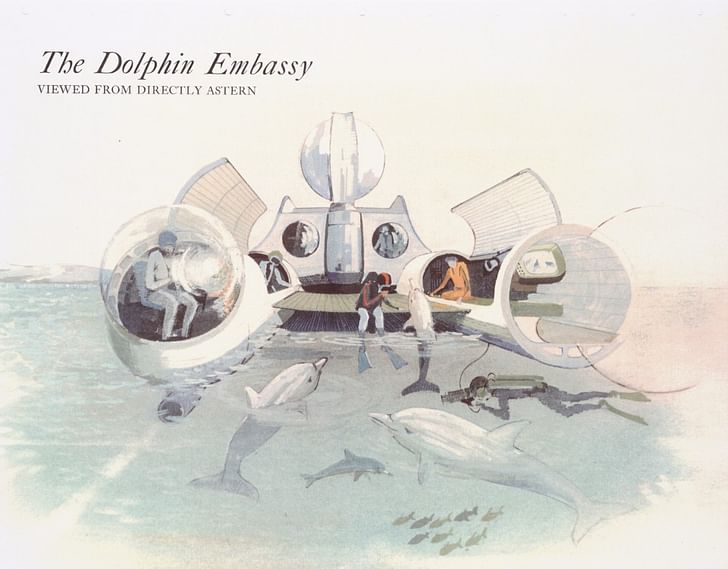
Most often the Ants invoke animality as a comic foil to the straight man of technology, tempering any impulse toward techno-utopianism with self-deprecating humor. In certain cases such as CARmen or the World’s Largest Snake, Ant Farm deploys an animal to satirize architecture itself. Though today we could attempt, with some earnestness, to define the Snake as a ‘duck,’ the inflatable precedes Learning from Las Vegas, and its zoomorphic form has no relation to its function. The Snake is not a capitalistic signifier but an architectural caricature. On the other hand, CARmen, as a performance piece, parodies through the Burlesque. Utzon’s iconic building becomes the ironic stage for Bizet’s opera turned cacophonous by a chorus of automobiles and a kangaroo.
More interplay between animals and machines can be seen in the fin, a techno-zoomorphic reference that has a lineage of its own in Ant Farm’s work (Fig. 2). The fin—a ‘soft’ scalene triangle with a leading, hypotenuse edge that emerges from a broad base and tapers toward a rounded upper vertex—was initially functionless and used only figuratively by the Ants, to evoke mobility and conjure the future. It first appeared in drawings as an automotive ornament, referencing the rocket-like tailfins that automakers developed in the Fifties. While General Motors’ designs were aeronautical in inspiration, there is no doubt that for Ant Farmers the tailfin also connoted aquatic fauna. Beyond describing the adornment as a “fish tailfin,” they often shaped their own designs after a dorsal fin and positioned them overhead rather than behind. When the Ants retrofitted a 1959 Cadillac Eldorado Biarritz (the model Thus the Dolphin Embassy would promote the positive aspects of animality—ecological accord, innocence, and playfulness—while preserving the enlightened aspects of humanity—scientific curiosity and technological innovation.legendary for the height of its tailfins) to become the ‘Phantom Dream Car’ in Media Burn (1975), they added an additional dorsal-tailfin atop the vehicle. Inside was a video camera that broadcast a live feed of the roadway to a television screen integrated into the dashboard (an opaque fiberglass bubble had replaced the vehicle’s windshield, rendering the driver blind). Here as a technological apparatus and automotive augmentation, Ant Farm’s fin acquired the navigational relevance of its biological counterpart. It left the realm of the cosmetic to become prosthetic.
The fin could also be inhabited. ICE-9, the vinyl inflatable that housed the group on road trips in the Media Van, was inspired by the tailfin of a jet airliner. In the Freedomland model (1973), the grotesque entrance pavilion with twin bullet Cadillac tail-lamps is also a fin reference. We could speculate that the fin’s lopsided profile influenced the shape of the House of the Century and, more abstractly, the short elevation extruded to become the Antioch Art Building (1972). However, we must also consider the fin’s affinity with the pyramid (and the pyramid’s two-dimensional abstraction), another recurrent image in Ant Farm’s oeuvre. In this context, the fin is but a partial-pyramid, a half-monument that retains iconic value while appearing more dynamic in shape (suggesting speed and directionality) and more organic in form (evoking a fleshy, animate body). If the pyramid referenced the past, the fin evoked the future.
This brief history of Ant Farm’s appropriation of the tailfin would be incomplete without mentioning the iconic Cadillac Ranch (1974), arguably the group’s best-known fin project. The Ranch is often defined in the context of consumer culture and its technological trends, but for Doug Michels it was a "dolphin idea." The ten Cadillacs, with noses half-submerged in a desert plain as flat as the sea, tailfins aloft, suggest dolphins caught mid-breach. This chimerical image, another techno-zoological mashup, reminds us that in the shadows of Ant Farm machines often lurk animals—which brings us back to the group’s zoopolitical monument and ultimate homage to the fin, the Dolphin Embassy, in whose non-human inhabitants the fish fin is re-embodied.
Human Embassy to the Dolphins
The climax of Ant Farm’s animal work, the Embassy critiques the processes of captivity and domestication through a satire of human geopolitical architecture. It rejects the model of traditional zoological spaces such as the menagerie, stable, and laboratory in order to curate a new diplomacy between human animals and their wild counterparts. In the Embassy, more than in other work, the Ants tinker with the ‘anthropological machine’ (and the built environment as a cog in said machine), that is, the historical constructs by which we understand ourselves as humans rather than ‘animals.’
Ant Farm’s utopian ambition, encapsulated in the alliterative banner ‘contact, communication, and coevolution,’ was to augment humanity and its biological legacy by translating ‘dolphinese’ and forming an unprecedented linguistic relationship with another intelligent species. Like the fabled Houyhnhnms, the enlightened race of horses whose language Gulliver learns on his travels, the mythical dolphins of this narrative are a wise and morally superior species living harmoniously together with their natural environment. Ant Farm has taken ecology (from the Greek oikos for ‘house’) back to its roots by designing an interspecies domicile.However, Ant Farm simultaneously rejects the technological primitivism of the Cetacean species, noted by Esquire in its tongue-in-cheek tagline to a 1975 Embassy article, “Bringing modern technology to the least developed nation of all.” Thus the Dolphin Embassy would promote the positive aspects of animality—ecological accord, innocence, and playfulness—while preserving the enlightened aspects of humanity—scientific curiosity and technological innovation. The Italian critic Germano Celant said it best of Ant Farm: “The idea is to possess more antennas, but naturally to remain more antlike.” To become-animal while simultaneously becoming-superhuman, Ant Farm proposed a hybrid program: a laboratory to further scientific advancement that also acts as a “prototype model community,” inhabited voluntarily and managed equally by a delegation of dolphins and humans. In the Embassy, playful artists practice alongside researchers employing a provocative, bilateral scientific methodology: the two species study one another. Technology acts as an interspecies telecommunication medium and architecture as the diplomatic chancery for radical cohabitation.
Contact: transterritorial trips
The Dolphin Embassy continues Ant Farm’s lineage of nomadic construction, work that defies architecture’s traditional spatial and temporal borders. A hypothetical ‘site plan’ of the project would look like a global map of dolphin habitat ranges, and within this vast context the vessel is geographically siteless (though an Australian home port was later presumed). In order to distinguish it from a second iteration, altered for cost and constructability, as well as the later Oceania version (by Doug Michels, Alexandra Morphett, and naval architect Allen Blackburne) Schreier refers to his original Embassy design as the ‘Research Vector John C. Lilly,’ or for short, the ‘RV John Lilly,’ both a nod to the scientist whose research on dolphin intelligence provided early inspiration for the Embassy and an obvious play on the North American term for a motorhome.
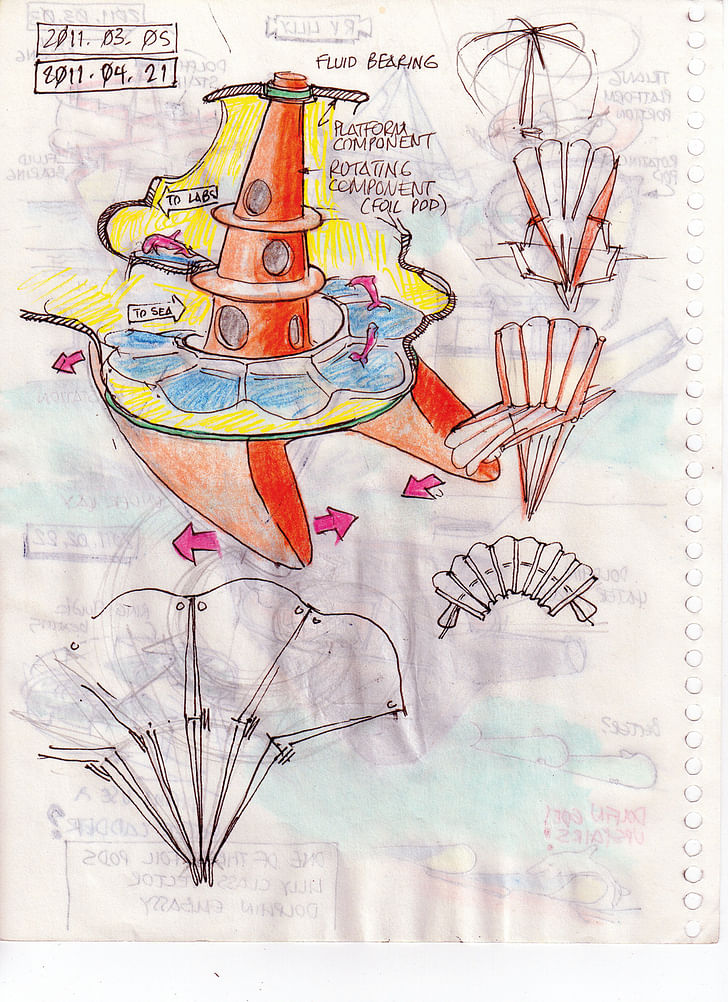
In its sitelessness the Embassy offers us a fictional contestation of the existing built world, seemingly outside the grasp of political establishments. On this point Ant Farm is explicit: one of the aims of the Embassy’s communications experiments is to “transcend land-based concepts such as politics and economics.” While it is ironic that the Embassy’s title references the diplomatic architecture of the statecraft that it rejects, the project is unaffected in its intention to represent a neo-political (or proto-political) space where ‘diplomacy’ means simply the cultivation of interspecies friendship. The Ants suggest that humanity’s terrestrial foundations constrain its sociocultural structures and they envision the fluid habitat of marine life as a new milieu for the reinvention of societal forms. The Embassy advances a geopolitical alternative in which humans occupy the sea as a “highly civilized public space” and planetary “agora” for the fellowship of earth’s most intelligent species. A lexical matrix, which Michels later designed for his FutureLab studio at the University of Houston’s College of Architecture, reinforces the rejection of telluric governance for a buoyant political landscape over which the dolphin symbolically presides, replacing the Democratic donkey and Republican elephant.
In addition to its location in geopolitical margins, the Embassy is sited at a biological frontier: the physiological threshold between exclusive habitats. The Embassy’s interior is a half-wet, half-dry artificial environment conducive to both species, neither ‘aquatic’ nor ‘terrestrial’ but, in the words of Ant Farm, “aquaterrestrial.” This portmanteau is significant, because, while ‘amphibious’ is rhetorically similar, ‘aquaterrestrial’ conveys new semantic value: not of two habitats distinct in space, but of a new, coextensive superhabitat. Thus the Dolphin Embassy is architecture as augmentation, as a radical life-support machine that exceeds political territories by defying biological boundaries.
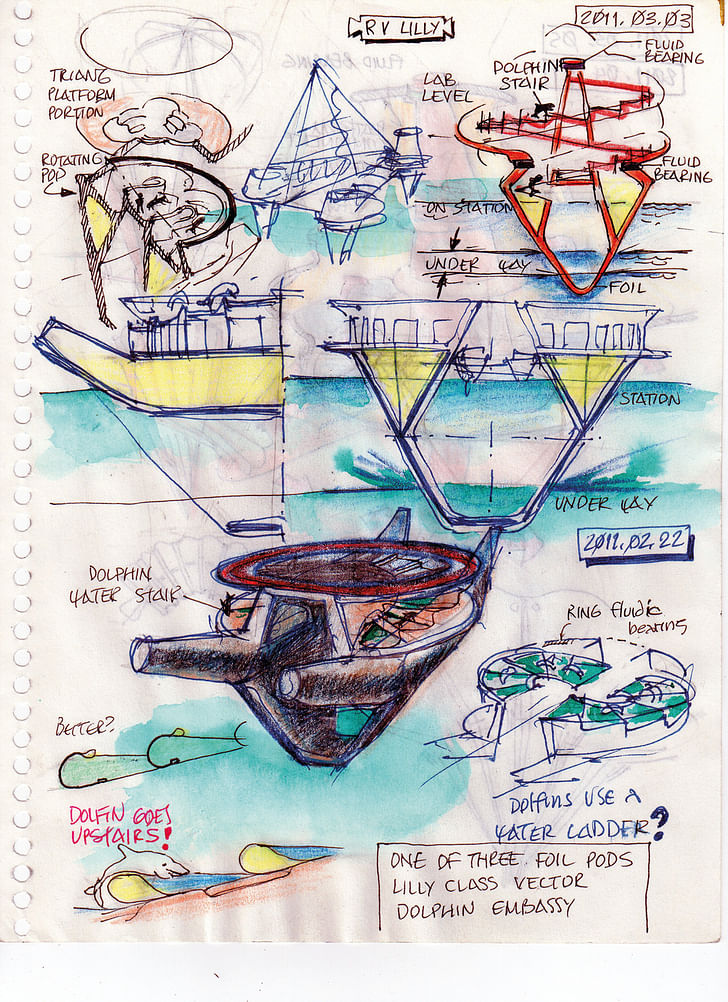
Communication: Delphic diplomacy
The Embassy’s macro-geometry and technological appendages, such as hydrofoils and antennae, suggest that it is merely a machine. But the vessel’s exterior skin appears supple and muscular, and its interior is further corporeal (Fig. 3). Its fluid-filled chambers and tubular passages evoke the canals of the inner ear, or cardiovascular circulation. Ant Farm’s fin motif reappears in the triangular pneumatic sail that rises above the open center of the craft; though more precisely, the sail oscillates between two biomorphic interpretations—Cetacean fin and Lepidoptera wing. Each panel of sailcloth converges to a point at the tack (fore corner) and is subtly arced to resemble a wing, an effect that is enhanced by the coloration—from the blue and green of the body of the sail to a band of red at the leech edge. In the case of the ‘Brain Room,’ the operation is biomimetic rather than biomorphic. Located at one vertex of the plan, this room is the technological ‘heart’ of the Embassy where Homo sapiens and Cetaceans use underwater computers, video recording, and sonar-recognition software to communicate and jointly navigate the craft. The distinct animal intelligences, like the two hemispheres of the vertebrate brain, are united by a shared technology-enhanced space that functions as a surrogate neural organ.
As biological revolutionaries, they don their architecture as a spacesuit. Together they drift, in the lull of a benign sea, toward an intelligent horizon.Though, ostensibly, interspecies dialogue aboard the Embassy occurs electro-mechanically, Doug Michels, at least, appears to have considered an alternative cybernetic channel for telecommunication: LSD, a somatopsychic tool rather than an electromechanical one. Both Michels and Embassy muse John C. Lilly had visual-telepathic experiences with dolphins while on acid trips (thus the second, more enigmatic meaning of Michels’ statement about Cadillac Ranch being a dolphin idea). No doubt hallucinogenic insight contributed to Michels’ mystical associations of dolphins, but also Greek legend played a role. The site of Delphi (and by association its prophetic Delphic Oracle) shares an etymological origin with the dolphin because it was in the shape of this animal that Apollo arrived there by sea.
If the ant was Ant Farm’s collective tutelary, the dolphin was Doug Michels’ personal one. For Michels, zoospatial practice outlived Ant Farm, and even his tragic death at a whale observation point a decade ago was marked by his engagement with cetaceans. His Dolphin Embassy redux in outer space, titled Project Bluestar (1987), and Michels Bollinger Architects’ entry for Dwell Magazine’s competition to redesign the White House, America’s Hood Ornament (2001), which features an indoor dolphin pool, merit future zoopolitical analysis. Late in his Ant Farm career, having moved to Australia to establish the Dolphin Embassy as a non-profit, Michels envisioned, along with Alexandra Morphett, a feature film entitled Brainwave, a pre-enactment of life aboard the Embassy that concludes with a collective human experience of transspecies telepathy. The plot may be nothing more than amusing science fiction. Yet it emerges as a critical detail in the story of the Dolphin Embassy, for Michels’ interest in parapsychological phenomena resituates Ant Farm’s engagement with technology in an expanded context that includes the body’s potential as a biological machine.

Coevolution: the laboratory and the living room
With the Embassy, Ant Farm defies the objective distance of the scientific process to promote cross-acculturation and affective bonding between species. As a live-work space, in addition to its scientific functions the Embassy must represent an interspecies home. Indeed, Ant Farm has taken ecology (from the Greek oikos for ‘house’) back to its roots by designing an interspecies domicile. The two species share spaces such as the ‘Interspecies Living Room’ in the hull opposite the brain room, and in the courtyard formed by the three hulls, the ‘Interspecies Backyard.’ Ant Farm cheekily represents the spaces of bourgeois domesticity in service of radical diplomacy with ‘alien’ life. Notably, however, this household lacks an interspecies bedroom—though perhaps its presence is implicit in the whimsical Dolphin Embassy emblem where the nude figures of a human and dolphin intertwine, a suggestive graphic as if lifted from a bestiality sex manual. No, in the Embassy the laboratory replaces the bedroom as the locus of evolution, a design that seems precocious in light of contemporary genetics research.
Whereas in later Embassy iterations the dolphins remain in their ocean environment and humans descend to them through openings in the hull, in the RV John Lilly dolphins ascend into the vessel. The ‘Dolphin Spiral Stair’ (Fig. 4), an Archimedes’ Screw-like structure in the entry hydrofoil, facilitates this movement upward into the vessel. While bordering on slapstick (picture legless creatures scaling a construction intended for bipeds), ascent up the dolphin stair is also metaphorically suggestive, recalling early biological classifications and the idea of the scala naturae (literally, the ‘stairway of nature’), in which animals were positioned below mankind and ranked hierarchically according to complexity. In moving vertically up into the Embassy, the mechanics of which engage Schreier to this day, dolphins allegorically ascend the biological ladder toward a taxonomic status equivalent to humans. (Incidentally, this ascent is echoed in today’s ethical movement to grant cetaceans legal rights as ‘non-human persons.’) The German thinker Peter Sloterdijk, following Nietzsche, has shown that humanism is fundamentally a socio-political project of domestication—a taming of beasts as well as a self-taming of man. In this light, Ant Farm’s Dolphin Embassy can be read as a reinvention of the humanist agenda through the founding a new domestic politics. Here is a radical planetary household not built on animal husbandry and traditional owner-pet narratives, which acts as an architectural currency for coevolution among speculators of biological identity.
Radar waves mingle with biosonar. Human and dolphin chatter merge. Plugged into the Embassy’s central processor, sheltered beneath a synthetic sky, the interspecies inhabitants are the prosthetic gods of an artificial kingdom. As biological revolutionaries, they don their architecture as a spacesuit. Together they drift, in the lull of a benign sea, toward an intelligent horizon. In researching the other, they search themselves: what new future lies within?

Also featured in HORIZONTE's Ausgabe 08:
Rethra: "The Wall Reconsidered"
Adamo Garritano & Christina Gaiger: "Delineation of a [Solid] Sea"
Emily Kutil: "Flying the Coop"
Andrea Alberto Dutto: "La Ligne Imaginot"
Kirsten Angermann: "Also Wie Bei Uns?"
BHRV: "Living Sections"
Interview with Alexander Schwarz
Sebastian Feldhusen: "Zur "Ästhetischen Grenze" des Architektonischen"
Christoph Eggersglüss: "Blumenkübelforschung"
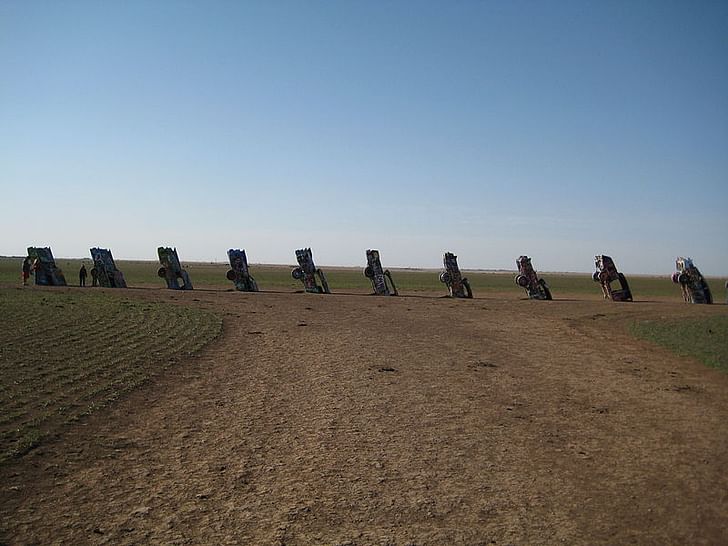
Former Managing Editor and Podcast Co-Producer for Archinect. I write, go to the movies, walk around and listen to the radio. My interests revolve around cognitive urban theory, psycholinguistics and food.Currently freelancing. Be in touch through longhyphen@gmail.com
5 Comments
Fantastic article, where can we find the whole issue?
You can order the issue online here: http://m18.uni-weimar.de/horizonte/
Amelia/Fred, even with Google Translate i couldn't get the website/online link/ordering to work.
Based on Google Translate and shipping prices being listed only for Europe/Germany am guessing not setup for international delivery. When I called the only bookstore listed as carrying the print in stock in USA (Hennessey + Ingalls in Santa Monica) they indicated they didn't carry/have at this time and didn't sound like they were awaiting shipments...
That's unfortunate. I've seen some earlier Horizonte issues on Amazon.co.uk, perhaps this particular one will also be listed there eventually. For now, if Hennessey + Ingalls isn't getting it in anytime soon, I'd suggest contacting Stella Simon, Horizonte's marketing and sales rep, at horizonte@archit.uni-weimar.de
sweet, thanks for tip!
Block this user
Are you sure you want to block this user and hide all related comments throughout the site?
Archinect
This is your first comment on Archinect. Your comment will be visible once approved.